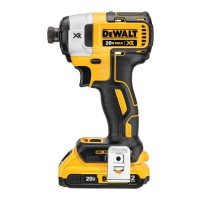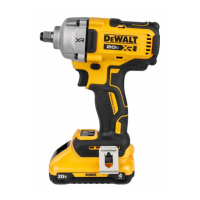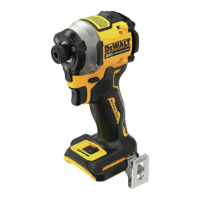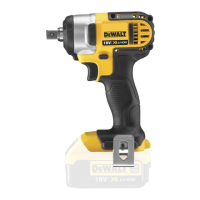20
ENGLISH
Belt Hook and Magnetic Bit Holder (Fig.A)
(Included with some models)
WARNING: To reduce the risk of serious personal injury,
DO NOT suspend tool overhead or suspend objects from the belt
hook. ONLY hang tool’s belt hook from a workbelt.
WARNING: To reduce the risk of serious personal injury,
ensure the screw holding the belt hook issecure.
IMPORTANT: When attaching or replacing a belt hook or
magnetic bit holder, use only the screw that is provided. Be sure
to securely tighten thescrew.
A belt hook
9
and magnetic bit holder
11
can be be attached
to either side of the tool using only the screw
10
provided,
to accommodate left- or right-handed users. If the hook or
magnetic bit holder is not desired at all, it can be removed from
thetool.
To move the belt hook or magnetic bit holder, remove the
screw
10
that holds it in place then reassemble on the opposite
side. Be sure to securely tighten thescrew.
OPERATION
Instructions for Use
WARNING: Always observe the safety instructions and
applicableregulations.
WARNING: To reduce the risk of serious personal injury,
turn tool off and disconnect battery pack before making
any adjustments or removing/installing attachments or
accessories. An accidental start-up can causeinjury.
Proper Hand Position (Fig. C)
WARNING: To reduce the risk of serious personal injury,
ALWAYS use proper hand position asshown.
WARNING: To reduce the risk of serious personal injury,
ALWAYS hold securely in anticipation of a suddenreaction.
Proper hand position requires one hand on the main handle
8
.
Variable Speed Trigger Switch (Fig.A, D)
To turn the tool on, squeeze the trigger switch
3
. To turn
the tool off, release the trigger switch. Your tool is equipped
with a brake. The chuck will stop when the trigger switch is
fullyreleased.
The variable speed switch enables you to start the application at
a slow speed. The further you squeeze the trigger, the faster the
tool will operate. For maximum tool life, use variable speed only
for starting holes orfasteners.
NOTE: Continuous use in variable speed range is not
recommended. It may damage the switch and should
beavoided.
Forward/Reverse Control Button (Fig.A, D)
A forward/reverse control button
4
determines the direction of
the tool and also serves as a lock-offbutton.
To select forward rotation, release the trigger switch and
depress the forward/reverse control button on the right side of
thetool.
To select reverse, depress the forward/reverse control button on
the left side of the tool. The centre position of the control button
locks the tool in the off position. When changing the position of
the control button, be sure the trigger isreleased.
NOTE: The first time the tool is run after changing the direction
of rotation, you may hear a click on start up. This is normal and
does not indicate aproblem.
Worklights (Fig.A)
There are three worklights
7
located around the 6.35 mm hex
chuck
6
. The worklights are activated when the trigger switch
isdepressed.
When the trigger is released, the worklight will stay illuminated
for up to 20 seconds. If the trigger switch remains depressed,
the worklights will remainon.
NOTE: The worklights are for lighting the immediate work
surface and are not intended to be used as aflashlight.
Quick-Release Chuck (Fig.A,E, F)
WARNING: Use only impact accessories. Non-impact
accessories may break and cause a hazardous condition. Inspect
accessory prior to use to ensure that it con tains nocracks.
NOTE: The chuck accepts 6.35mm hex bit tips only. Using
25mm bits allows better access in tightspaces.
Place the forward/reverse button
4
in the locked off (centre)
position or remove battery pack before changingaccessories.
To install an accessory (Fig. E), push accessory to fully insert
into chuck
6
. The chuck collar
5
does not need to be pulled up
to lock accessory inplace.
To remove an accessory (Fig. F), pull the chuck collar away
from the front of the tool. Remove the accessory and release
thecollar.
USAGE
Your impact tool generates the following maximum torque:
Cat # Nm Ft.-Lbs. In.-Lbs
DCF809 190 142 1700
CAUTION: Ensure fastener and/or system will withstand the
level of torque generated by the tool. Excessive torque may cause
breakage and possible personalinjury.
1. Place the accessory on the fastener head. Keep the tool
pointed straight at thefastener.
2. Press switch to start operation. Release the switch to stop
operation. Always check torque with a torque wrench, as
the fastening torque is affected by many factors including
thefollowing:
• Voltage: Low voltage, due to a nearly discharged battery, will
reduce fasteningtorque.
• Accessory size: Failure to use the correct accessory size will
cause a reduction in fasteningtorque.
• Bolt Size: Larger bolt diameters generally require higher
fastening torque. Fastening torque will also vary according to
length, grade, and torquecoefficient.
• Bolt: Ensure that all threads are free of rust and other debris to
allow proper fasteningtorque.
• Material: The type of material and surface finish of the material
will affect fasteningtorque.
• Fastening time: Longer fasten ing time results in increased
fastening torque. Using a longer fastening time than recom-
mended could cause the fasteners to be overstressed, stripped
ordamaged.
MAINTENANCE
Your DeWALT power tool has been designed to operate
over a long period of time with a minimum of maintenance.
Continuous satisfactory operation depends upon proper tool
care and regularcleaning.

